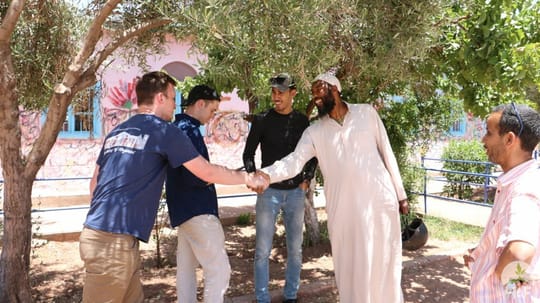HAF Intern, UVA Student

I went to Ait Ourir, a city about 30 minutes outside of Marrakech to visit the Riad school. The school is surrounded by a six-foot wall that is covered by murals mainly pertaining to environmental issues. The school currently has 1,222 students, with boys and girls ages 5-12 years old, 480 of the students are girls. There are 30 teachers at the school who teach every subject from Arabic to Ecology. The school built in 1981 heavily emphasizes recycling and environmental consciousness, the tables and chairs in the courtyard are made from recycled tires and old wood. The Riad school does not only recycle, they also grow olive trees and orange trees in the hopes of selling the fruits of their labor. When I asked the headmaster Housine what the greatest challenges facing the Riad school where he told me they were lacking a proper irrigation system and its bathrooms were inadequate given the amount of students he had. A proper irrigation system would cost around 15,000 dirhams or $1,500 dollars with the bulk of the cost going to equipment.
It is evident how invested the faculty is in their school and their students, especially when you meet one of their Arabic teachers, Omar. Omar is born and raised in Morocco and recalls having a passion for teaching from the time he was “small” as he words it. He teaches children Arabic and Grammar who are 6-7 years old and he has a smile on his face that is brighter than a lighthouse. At the Riad school it is not just education as usual, it is education centered around sustainability and environmental consciousness.

The purpose of our visit was to demonstrate how sustainability is established and how to utilize time and relationships to our benefit. As an icebreaker each person had to find two people to form a group of three without making eye contact or searching for a specific person. The purpose of this was to demonstrate that a productive approach to sustainability requires actors to be versatile and creative. Sustainability is about collaborating with others and working with what you have available, not what you desire. Following the icebreaker the students divided themselves into four groups to discuss what they believed would be most beneficial for their community in the future.

Their suggestions included a community garden, a reliable form of transportation for students to go to the University, a library and a cultural center. Each suggestion seemed to be equally desired among the students which made it difficult to determine which addition to the community would be most needed. In response the students debated based off of the extent and range of the benefits provided by each suggestion, followed by a democratic vote to eliminate other suggestions. I was taken back by how cordial the students were in their debates and how well they articulated their thoughts to defend their suggestions. They were so persuasive and pragmatic in their arguments that it actually made it difficult to decide which idea to support. At the conclusion of the day I had a better understanding of the importance of consolidating ideas and it was evident that the students did too.
